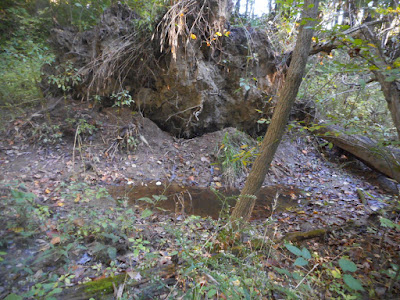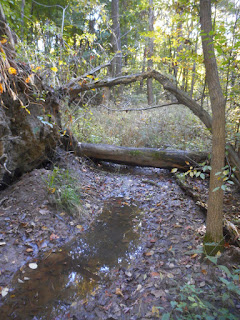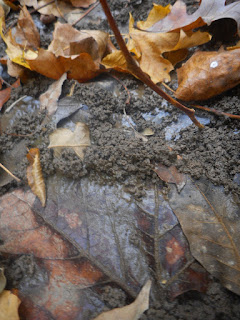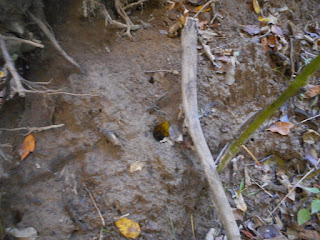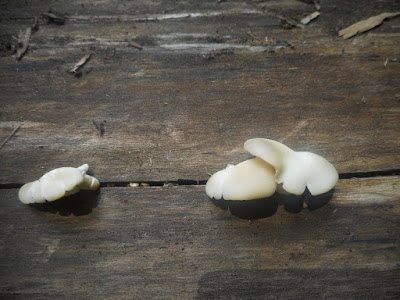Invasive
Plants and Giant Woolly Bears!!
November 4, 2016
November 4, 2016
Autumn
was, so far, unseasonably warm, and rather crisp from lack of
significant rain. November 4 was a bright, sunny day, with a clear,
baby blue sky.
Canopy over Cottonwood Pond
Because
of these rather non-autumnal conditions, autumn color was slow to
appear. On November 4, there was still more green in the trees than
what is usual for early November, but other colors had been allowed
to peak out from behind covers of chlorophyll increasingly since
October 31. The woods had begun to take on the warm glow of the
yellow-gold to maroon to deep bronze spectrum.
Looking up the slope I had descended
A nearby Sugar Maple, finally turning gold
Blue Beech saplings on the base of the fallen Cottonwood trunk
Sugar Maple sapling on top edge of Root Ball
During
the previous three to four days, since I had last been to Cottonwood
Pond, the dry leaf layer on the woods floor had become deeper and
more varied in texture as a greater variety of trees were letting go
of their leaves.
Creek near Cottonwood Pond
Leaf-filled Creek - looking upstream
Very Rotten Log over Creek
Very Rotten Log with dry leaves and new green plant
An insect larva had spun this cocoon when the leaf was green and pliable, attaching silken fibers and pulling them toward itself. It is snug for the winter.
Our
shaggy-haired gnome face (the Root Ball Bottom) was looking sleepy,
as if resting more deeply into the Mud Pile pillows.
Fallen
leaves were gathering into the bowl of earth that is normally
Cottonwood Pond. On that day, the bowl, the Inlet, the Isthmus and
“little pond” were all dry.
Looking across the main pond bowl toward the Inlet
Northern pond corner, and the Isthmus connecting it with “little
pond.”
“little pond” on the topside of the Root Ball
A little bit of water from a recent light rain rests on a leaf in
the bed of “little pond”
Interesting designs in the wood at the base of the fallen
Cottonwood Trunk, edge of “little pond”
The
fallen Cottonwood Trunk was sporting some fresh mushrooms.
A large section of the south-facing side of the Trunk had been rotting
significantly, its old wood carved into “apartments” by various
small animals, which help break down the wood into soil. New soil
could be seen in some of the crevices where it had fallen. The dead
leaves that had fallen and nestled into cradled areas would also
break down to become part of that soil. I couldn't help but be
reminded of Pueblo cliff dwellings.
Something
that had been really bugging me for a long time was the existence of
Asian Bush Honeysuckle shrubs (various Lonicera species) in
the Cottonwood Pond vicinity, very close to “little pond”, the
Trunk and the Swampy Spot. These types of non-native shrubs are some
of the worst invasive plants in our area. They grow quickly in dense
thickets that crowd out native plants and choke out the sunlight that
would otherwise reach and enrich herbaceous plants below.
Furthermore, they have an allelopathic affect on other plants,
preventing them from growing around the shrubs. What eventually
appears is a monoculture of Asian Bush Honeysuckle with
bare ground underneath.
These
shrubs, over the years, have been marching into our woods from either
end, and we had only made a small dent in the population with our
sporadic efforts to control them. While walking the woods, I pulled
up any smaller ones that I could (they pull up easily), but there
were many larger ones – some with branches as thick as my wrists –
that must be otherwise controlled, calling for a stronger, more
consistent effort.
I
had only found two of them associated with Cottonwood Pond, so I
decided that November 4 was the day I would go do something about
them before they spread further. My original plan was to cut the
trunks off below the crown. When researching Asian Bush Honeysuckle
control methods, my husband had discovered this idea. He tried it out
on a few of the shrubs closer to the road and … they died! I
thought it would be nice to try this on the Cottonwood Pond shrubs,
leaving herbicide behind.
But,
I brought the wrong tool. All I brought was my little pruning saw. I have
used it to cut thick old Winter Creeper vine on trees. I did not
realize the difference.
I
first went to the specimen situated on the north side of the fallen
Cottonwood Trunk. It was younger, not having produced flowers or
fruit, so it was good to catch it so soon.
Foreground – young Asian Bush Honeysuckle shrub
Mireille
insisted on “helping.”
I
cleared away leaves and soil from the base, to get to the crown (the
part of the plant where the stems meet the roots.)
What
I revealed was a beautiful, hairy, curled up caterpillar – and a
quite large one.
It
had rows of black spines with deep orange-red stripes between. I had
been seeing many of these during late summer through early autumn –
making their way through the grass near the clothesline, curled up at
the base of the Persimmon tree or near some brick garden edging –
all over the place. They look much like the familiar Woolly Bear
caterpillars that wiggle in droves across our road in September,
except for the alternating red stripes and the very large size.
Because
I had been seeing so many, I looked them up and learned about them.
They are the Giant Woolly Bear Caterpillars! Their Latin name is
Hypercompe scribonia. You can learn more about them here ...
… where
you can also see a photo of the absolutely stunning black-and-white
adult that it becomes – the Great Leopard Moth. This is the largest
of the Eastern Tiger Moths. With so many of these caterpillars about,
I am hoping to see the moths.
Though
the caterpillar looks like a “don't touch!” type (indeed, some
caterpillars have venomous spines or hairs), this one is safe to
touch. The hairiness and bold stripes, though, serve as a warning to
possible predators that might consider this one to be venomous,
therefore being more likely to avoid it.
This
caterpillar, and others I have seen of its kind, stays very tightly
curled up when disturbed (so much so that I've wondered if they were
still alive.) When I have moved them to safer places, they have
stayed stiffly in this position, not even uncurling after I set them
down. The above web site article shed light on this phenomenon:
“When
threatened, giant woolly bears curl up tightly to protect their
vulnerable undersides. When picked up, their stiff, smooth spines are
bent backward and they tend to push the caterpillars forward and out
of the grip (Wagner 2009). Because of this, it is virtually
impossible to forcibly uncurl them when they are in the defensive
posture. Also, in this defensive posture, their bright red
inter-segmental areas are highly visible “
By
the way, by perusing this article you can learn other fascinating
things about this animal, such as (with the moth) where its ears are
located and how they are used, and how they produce high frequency
clicks in response to bat sonar (bats are one of their greatest
predators), and also how the larvae (caterpillars) resist freezing.
The
site also has a list of host plants (plants favored in this species'
larval diet.) Many of those plants grow at our place, in the woods,
gardens, yard, fields, etc. This caterpillar is resourceful. There
are some species of caterpillars dependent on only one to three
species of plants for food (such as Paw-Paws for Zebra Swallowtail,
and Yucca for the … Yucca moth), but the survival of a species can
be more assured if it has a more diverse diet (more chances that food
is available somewhere.) One of the plants on the list is Tatarian
Honeysuckle (Lonicera tatarica), one of the non-native, invasive
species of Asian Bush Honeysuckle. I don't know that this is the
species near Cottonwood Pond, but I also wondered if other species of
Asian Bush Honeysuckle serve as food for this caterpillar.
So,
I got out my pruning saw and got down on the ground. It became
evident that this tool was too puny for the job as I started to saw
into the thick, hard area below the crown. Maybe it would work, but
it would take all day.
All
I could do was go ahead and saw the trunks above the soil line. The
little saw when through them like butter – well, partially frozen
butter – much easier. I wanted these things gone. But, after doing
this, my choices for killing off the whole plant would be to either
go back later with the right tool and attack the crown, or go back
later with the right herbicide to smear on the cut parts (which, if I
waited too long, I would have to re-cut.) If I did neither, the shrub
would come back with vengeance, sprouting numerous new, vigorous
stems, as if to say, “Hah! I'll show YOU who's boss!”
Here
are before-and-after photos:
Next,
it was time to address the one to the south side of the Cottonwood
Trunk, next to the Barkless Log extension.
This
one was further along, having flowered in the spring, and then
producing berries, which would probably be eaten by birds who would
spread the seed elsewhere, adding to the huge Asian Bush Honeysuckle
problem we already had.
Asian Bush Honeysuckle in fruit - berries between pairs of opposite leaves
Asian Bush Honeysuckle berries on the ground
Again,
I moved leaves and soil away from the shrub's base to expose the
crown …
… but
saw that this would also be too formidable for my little saw. So, in
the time it takes me to say “get rid of this Asian Bush
Honeysuckle", I cut the trunks.
It
had been growing next to a young tree. Here are before-and-after
photos, taken from the other side of that tree:
After
I had finished, I took all of the trunks and branches from both
shrubs and piled them in a nearby, out-of-the-way spot on the slope.
They could then become cover for small woodland animals.
Cut Asian Bush Honeysuckle branches piled near base of tree
Close
to the second Honeysuckle shrub was the grove of Elderberry shrubs.
How could I tell the difference, so that I didn't cut down valuable,
native Elderberry plants? First of all, the difference in the leaves.
Leaves of Elderberry shrubs
Elderberry
has compound leaves, meaning a leaf shaft is composed of several
leaflets. These are arranged oppositely, and each leaflet has a
toothed edge.
On
the other hand, though Asian Bush Honeysuckle has opposite leaves,
they are single leaves, and are paired with the red berries between
each pair. The leaves have smooth edges and stay green longer than
any other leafy plant in the woods (see previous Honeysuckle photos.)
Another way to distinguish them is through the bark on their trunks. Asian Bush Honeysuckle has a distinctive streaky look. Elderberry bark is smoother in comparison, with distinctive lenticels - the dark, bumpy spots that are scattered about on it.
After
accomplishing this task, I wandered up the back slope for a nice walk
in the now colorful autumn woods, dry leaves crunching underfoot,
November light slanting through the woodland. I looked back down at
the site of Cottonwood Pond, which looked so different from that
vantage point. I felt I had helped the area by cutting away the
invasive shrubs, though I would have to be sure to go back sometime
soon to truly finish the job.
Meanwhile,
I was sure the Giant Woolly Bear caterpillar was still curled up in
the safe place where I had moved it, waiting for winter.





















































